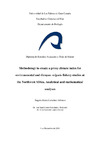Please use this identifier to cite or link to this item:
https://accedacris.ulpgc.es/handle/10553/1871
| Title: | Methodology to create a proxy climate index for environmental and Octopus vulgaris fishery studies at the Northwest Africa: analytical and mathematical analyses | Authors: | Caballero Alfonso, Ángela María | Director: | Castro, J.J. Ganzedo López, Unai |
UNESCO Clasification: | 240119 Zoología marina | Keywords: | Noroeste de África Pulpo Pesca Atlántico Norte Factores climáticos |
Issue Date: | 2008 | Abstract: | Several proxy indices have been built in local scales attempting to explain fluctuations of other variables, mainly climatological, which have regional interest (Chen, 1982; Trenberth, 1984; Dünkeloh and Jacobeit, 2003; Martín-Vide and López-Bustins, 2006; among others). In order to study the longitudinal low-frequency variability over the North-east Atlantic in the 20º-50ºN and 45ºW-20ºE domain through Sea Level Pressure (SLP) data sets, two methodological approaches are going to be applied. The first one is an analytical procedure; wheras the second is a mathematicalone trough a Principal Component Analysis (PCA). Apart from that a review about other climatic indices over the North Atlantic Ocean and about the North-east pressure system have been done. The longitudinal movement of the Azores High is highlighted through an Azores-Liguria Index (ALOi), which has been built in the present study following the analytical method. It has been contrasted with other climatic indices over the North Atlantic Ocean. Then, the obtained climatic proxy indices (ALOi, NAOs andprincipal components results) were correlated with some fisheries data series to elucidate if the climate variations are the cause of the catches fluctuations in the West 1 Caballero-Alfonso, A. M. et al. African coast. Significant correlations of the proxy indices have been found with Sea Surface Temperature (SST) and wind stress (W). When correlating octopus catches data with climate variables for the considered domain, significant Pearson correlations were found for the NAO (0.332 < R > 0.394) with one lag, ALOi (for annual: R = -0.363 and -0.402; spring: R = -0.312 and -0.310 and summer: R = -0.325 and -0.302, time-scales) with two lags and with the Principal Component 3 (PC3. R = 0.515) with one lag. This fact enhances the importance of the W and SST in the region when considering the fisheries resources. | Description: | Máster en Oceanografía | Department: | Departamento de Biología | Faculty: | Facultad de Ciencias del Mar | URI: | https://accedacris.ulpgc.es/handle/10553/1871 |
| Appears in Collections: | Trabajo final de máster |
En el caso de que no encuentre el documento puede ser debido a que el centro o las/os autoras/es no autorizan su publicación. Si tiene verdadero interés en el contenido del mismo, puede dirigirse al director/a o directores/as del trabajo cuyos datos encontrará más arriba.
Show full item recordPage view(s)
172
checked on May 17, 2025
Download(s)
83
checked on May 17, 2025
Google ScholarTM
Check
Share
Export metadata
Items in accedaCRIS are protected by copyright, with all rights reserved, unless otherwise indicated.
